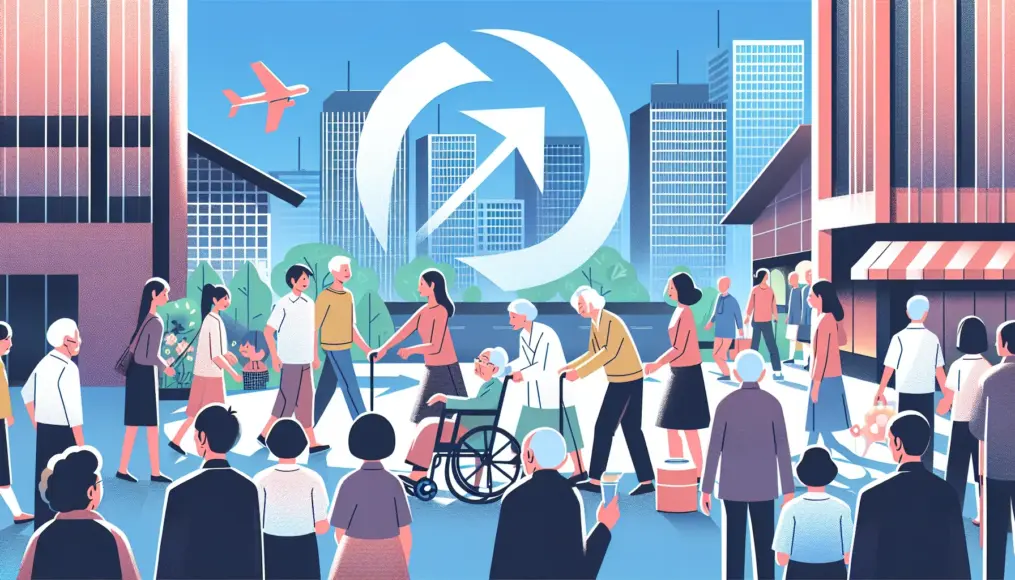The issue of declining birthrates and an aging population is having a profound impact on our society. However, instead of viewing this challenge merely as a crisis, let’s consider it an opportunity to find solutions from a fresh perspective. There is a lot we can do to create a better future.
In this article, we will reevaluate the current state of declining birthrates and an aging population, proposing innovative solutions through a contrarian approach. By recognizing the limitations of traditional measures and exploring avenues for intergenerational cooperation and the use of technology, we can chart a path toward a sustainable society. We’ll also touch on future policy proposals as we prepare to embrace a new era.
While the challenges posed by declining birthrates and an aging population are unavoidable, our proactive efforts toward solutions can reshape our future. So, let’s think together about what we can do.
- Rethinking the realities of population decline and aging
- Moving from traditional measures to fresh proposals
- Concrete strategies for achieving a sustainable society
Reevaluating the Current State of Japan’s Aging Population and Declining Birthrate
The declining birthrate and aging population are critical issues that modern societies are grappling with. Many countries, including Japan, are experiencing a drop in birth rates alongside an increase in the elderly population, leading to various social challenges. It’s crucial to understand this situation accurately and find appropriate solutions. Let’s take a closer look at the realities of population decline and the progression of an aging society.
The Reality of Population Decline
In Japan, the trend of declining birthrates is evident, with economic concerns and the difficulties of balancing work and parenting playing significant roles. As a result, the population is steadily decreasing, which could lead to labor shortages and economic stagnation in the future.
Moreover, this population decline is exacerbating rural depopulation, threatening the vitality of local communities. To address this issue, concrete measures to increase the birthrate are essential.
- Declining birthrate in Japan is ongoing
- Economic concerns and parenting burdens are contributing factors
- Rural depopulation and loss of community vitality
The Progression of an Aging Society
On the flip side, the advancement of an aging society cannot be overlooked. Improvements in medical technology and living conditions have extended average life expectancy, but they have also led to an increase in the proportion of elderly individuals. This growth poses challenges to pension and healthcare systems, threatening the sustainability of society.
The rising social security costs associated with an increasing elderly population place a heavy burden on younger generations. Therefore, it is imperative to create a societal framework that allows older adults to thrive and contribute.
For those who want to delve deeper into the realities of the declining birthrate and aging population, I recommend checking out this article on “Specific Measures to Address the Aging Population and Low Birthrate.” This piece explores a range of solutions from economic perspectives, policy reform, and the role of local communities, providing valuable insights into ways to build a sustainable society.
- Increase in elderly population due to longer life expectancy
- Growing burden on social security systems
- Building a society that considers the impact on younger generations
Finding Solutions Through Contrarian Thinking
In addressing the challenges of Japan’s declining birthrate and aging population, numerous traditional measures have been attempted. However, many aspects of this issue remain stubbornly resistant to conventional solutions. By approaching the problem from a different angle, we may uncover entirely new strategies. This section will examine the limitations of traditional approaches and focus on fresh perspectives for potential solutions.
The Limitations of Traditional Approaches
Historically, policies aimed at mitigating the declining birthrate have focused primarily on boosting birth rates and promoting employment for the elderly. Unfortunately, these measures often yield only temporary results and frequently fail to address the root causes of the issue. For instance, while extending parental leave and improving childcare facilities have been implemented, these initiatives alone are unlikely to produce significant long-term effects.
Moreover, simply increasing job opportunities for older adults does not necessarily enhance their health or quality of life. Recognizing these limitations is crucial as we seek more effective solutions to these pressing challenges.
- Traditional policies yield only temporary results
- Limitations of birthrate enhancement measures
- Quality of employment for the elderly
Proposing New Perspectives
Incorporating contrarian thinking can reveal innovative solutions to the declining birthrate and aging population issues. For example, creating a system where childcare is supported by the entire community could alleviate individual burdens. This might involve strengthening local communities and establishing frameworks for people of all ages to collaborate in raising children.
Additionally, developing programs that leverage the experience and knowledge of older individuals can enhance overall societal productivity. Such new perspectives could significantly contribute to resolving the challenges posed by Japan’s demographic shifts.
As you consider solutions to the declining birthrate and aging population using contrarian thinking, we encourage you to explore related articles. In particular, this piece “Practical Approaches to Solve the Low Birthrate Problem!” offers concrete solutions for Japan’s future, which is profoundly affected by low birthrates. Approaching the topic from this angle may deepen your understanding of the issue even further.
- A community-supported system for childcare
- Programs to utilize the experience of the elderly
- Enhancing productivity through collective societal cooperation
Striving for a Sustainable Society
As Japan faces the challenges of a declining birthrate and an aging population, building a sustainable society becomes increasingly vital. Achieving this requires collaboration between generations and the effective use of technology. By fostering cooperation between younger and older generations, we can create a society where everyone supports one another. Additionally, embracing the latest technologies can enhance our quality of life while providing solutions to various social issues. In this section, we will explore ways to promote intergenerational collaboration and leverage technology.
Promoting Intergenerational Collaboration
Intergenerational cooperation is a key component in constructing a sustainable society. By increasing opportunities for interaction and joint activities between younger and older generations within local communities, we can deepen mutual understanding. For instance, participating in community events or volunteer activities can foster connections that transcend age barriers.
It’s also essential for younger generations to adopt a mindset of learning from older individuals. By tapping into the experiences and knowledge of seniors, innovative ideas may emerge to address community challenges. Such collaboration can pave the way for a better society.
- Increasing opportunities for interaction between younger and older generations
- The importance of community events and volunteer activities
- The significance of leveraging seniors’ experiences
Harnessing Technology
Technology has the potential to play a significant role in addressing the challenges posed by an aging population and declining birthrates. For example, the rise of remote work and online education has diversified how we work and learn. This shift allows older adults to work comfortably from home and provides young people with flexible learning opportunities.
Moreover, advancements in technology are expected to greatly enhance health management. Utilizing wearable devices and health management apps can make it easier to monitor the health status of seniors, enabling timely and appropriate interventions. By harnessing technology in this way, we can take meaningful strides toward building a sustainable society.
- The rise of remote work and online education
- Utilizing technology for health management
- The importance of monitoring seniors’ health status
Policy Proposals for a Sustainable Future
As Japan faces the challenges of a declining birthrate and an aging population, it’s crucial to develop policy proposals that look towards the future. Among these, reforms in education and employment are essential for nurturing the next generation and revitalizing the economy. Additionally, strategies for regional revitalization and urban planning are needed to enhance local appeal and promote sustainable development. In this section, we will explore policy proposals based on these themes.
Reforms in Education and Employment
Education serves as the foundation for a thriving future society. To adapt to our rapidly changing world, a reevaluation of the education system is necessary. In particular, the introduction of STEAM education (Science, Technology, Engineering, Arts, and Mathematics) is gaining importance. This approach fosters creativity and problem-solving skills, equipping students to be competitive in the future job market.
Moreover, employment reforms are equally critical. By promoting flexible work arrangements and the widespread adoption of remote work, we can create an environment that is more accommodating for a diverse workforce. This will enable individuals across generations—from young adults to seniors—to thrive in the labor market.
- The Importance of STEAM Education
- Fostering Creativity and Problem-Solving Skills
- Promoting Flexible Work Arrangements
Regional Revitalization and Urban Planning
Regional revitalization is a key policy aimed at restoring vitality to local communities. In rural areas, there is a pressing need to promote industries that leverage local resources and strengthen tourism that capitalizes on regional characteristics. These efforts can help retain young people in their communities while also attracting newcomers from outside.
In urban planning, creating sustainable cities is of paramount importance. Enhancing transportation infrastructure and increasing green spaces like parks can significantly improve the quality of life for residents. It’s also vital to design spaces that foster the formation of community connections.
For those interested in learning more, we recommend checking out this article, “A Deep Dive into Government Efforts on Declining Birthrates: Realities and Challenges from Personal Experiences.” It provides an in-depth look at government initiatives and the challenges they face, enriched with real-life stories. Be sure to take a look!
- Promoting Industries that Utilize Local Resources
- The Importance of Sustainable Urban Development
- Creating Livable Environments
Conclusion
The challenges posed by a declining birthrate and an aging population have a significant impact on our society. However, as suggested in this article, approaching the issue from a different perspective can reveal new solutions. It’s essential to recognize the importance of intergenerational cooperation, leveraging technology, reforming education and employment, and understanding the significance of regional revitalization and urban planning as we strive for a sustainable society.
To implement these policies effectively, it’s crucial for the entire community to collaborate and establish a system where different generations support one another. Addressing the issue of a declining birthrate and an aging population won’t yield immediate results, but persistent efforts can indeed pave the way for a brighter future.
- Intergenerational cooperation is key to solving the declining birthrate and aging population
- Utilizing technology can enhance the quality of life
- Reforming education and employment will cultivate the workforce of the future
The issue of a declining birthrate and an aging population is one that affects us all. We’d love to hear your thoughts and opinions in the comments!



Comment